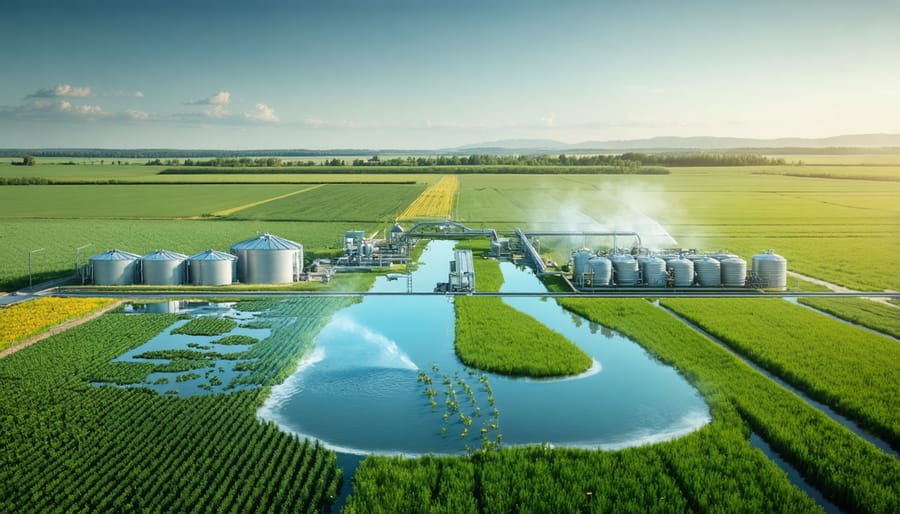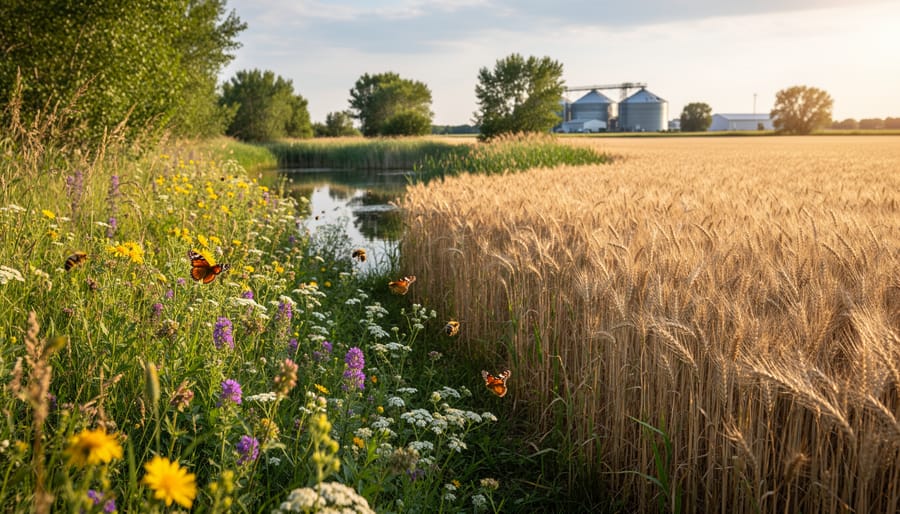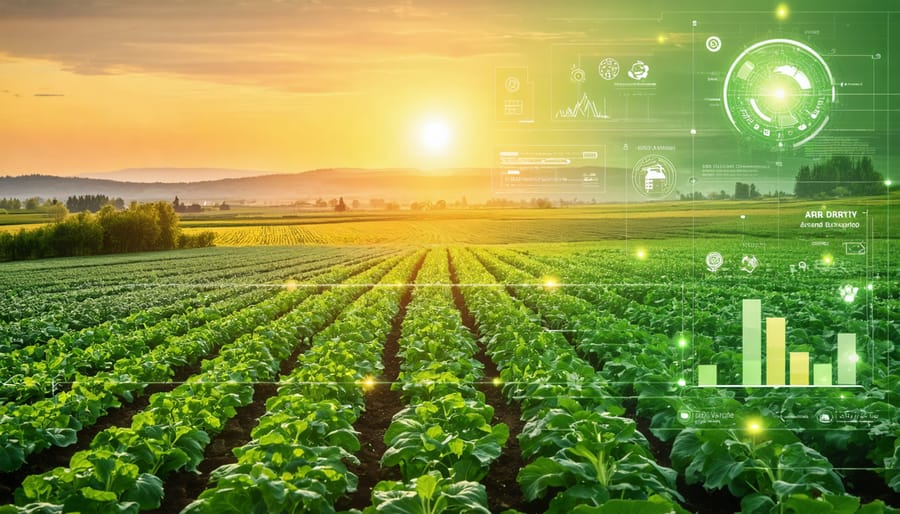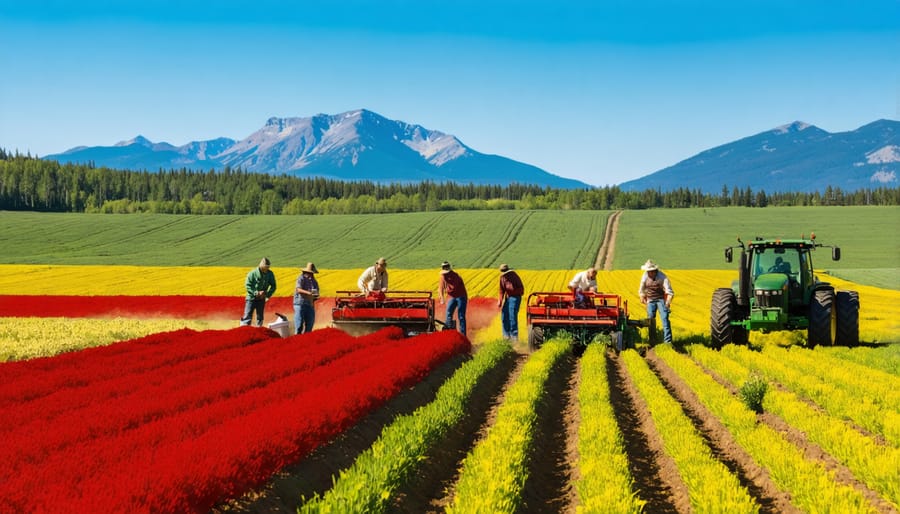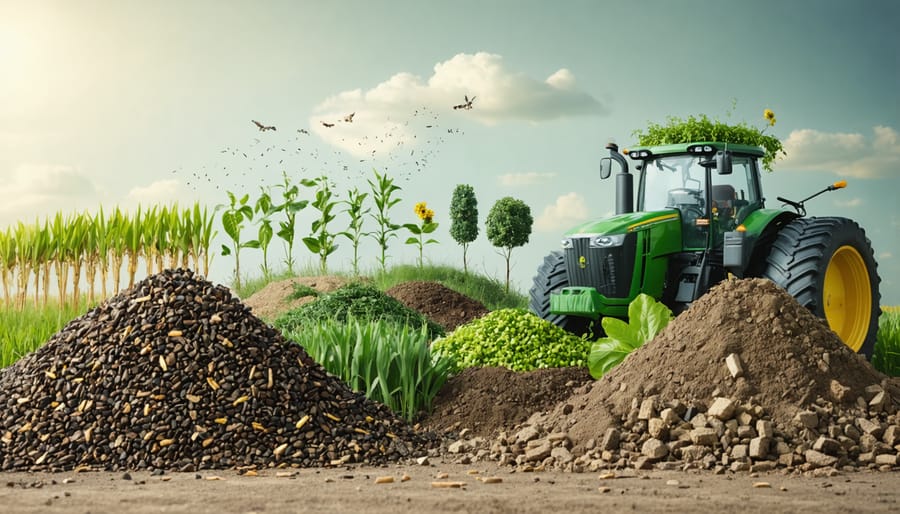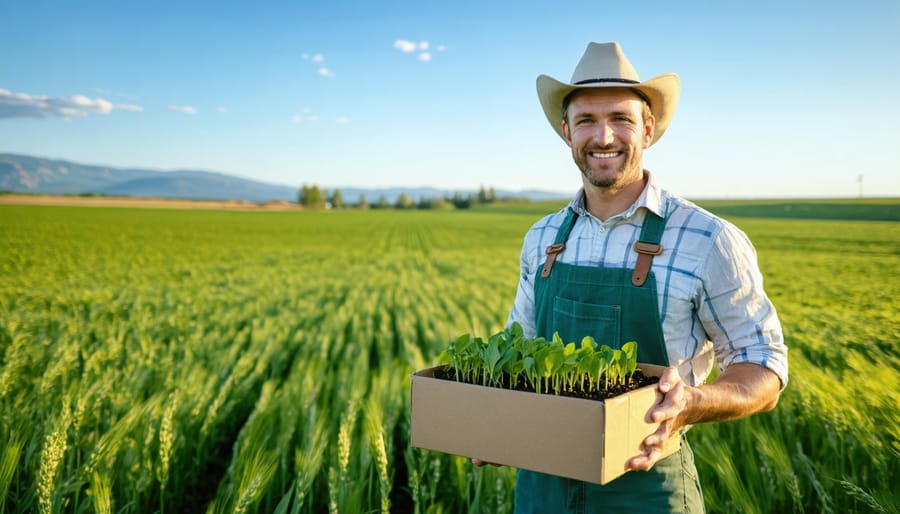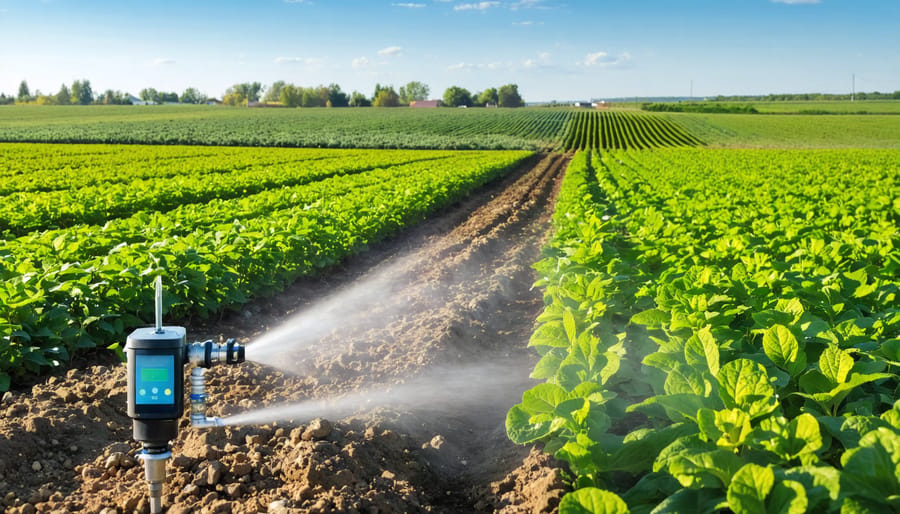Water conservation stands at the forefront of sustainable agriculture in Canada, where Prairie farmers manage over 50 million hectares of cropland with increasingly unpredictable rainfall patterns. Every drop saved translates directly into economic resilience and environmental stewardship for Alberta’s agricultural operations. Recent data from Agriculture and Agri-Food Canada reveals that efficient water management can reduce farm operating costs by 15-30% while maintaining or improving crop yields.
For Canadian farmers, particularly in Alberta’s semi-arid regions, water conservation isn’t just an environmental concern—it’s a critical business strategy. With agricultural operations consuming approximately 70% of the province’s water supply, implementing effective conservation practices has become essential for long-term farm viability. The changing climate patterns across the Prairies, combined with increasing competition for water resources, make it imperative for agricultural professionals to adopt innovative conservation techniques.
Our research, conducted in partnership with local farming communities and agricultural extension services, demonstrates that proactive water management strategies can help operations maintain productivity even during periods of water stress, while contributing to the broader goal of sustainable resource management in Canadian agriculture.
The True Cost of Water Waste in Alberta’s Agricultural Supply Chain
Current Water Usage Statistics in Alberta Agriculture
According to recent Alberta Agriculture and Irrigation data, the agricultural sector accounts for approximately 45% of the province’s water consumption, with irrigation being the primary use. In 2022, Alberta farmers used an average of 1,500 cubic metres of water per hectare for irrigated crops, though this varies significantly by crop type and region.
The South Saskatchewan River Basin, which supports 70% of Alberta’s irrigation districts, has seen a 15% increase in water demand over the past decade. Currently, about 1.7 million acres of farmland in Alberta rely on irrigation systems, with this number projected to grow by 200,000 acres by 2025.
Despite technological improvements, studies show that nearly 20% of irrigation water is lost through inefficient distribution systems and outdated practices. However, farms using modern pivot irrigation systems report water savings of up to 25% compared to traditional flooding methods.
Recent monitoring in the Lethbridge region indicates that farms implementing precision irrigation techniques have reduced their water usage by an average of 30% while maintaining or improving crop yields, demonstrating the potential for conservation without compromising productivity.
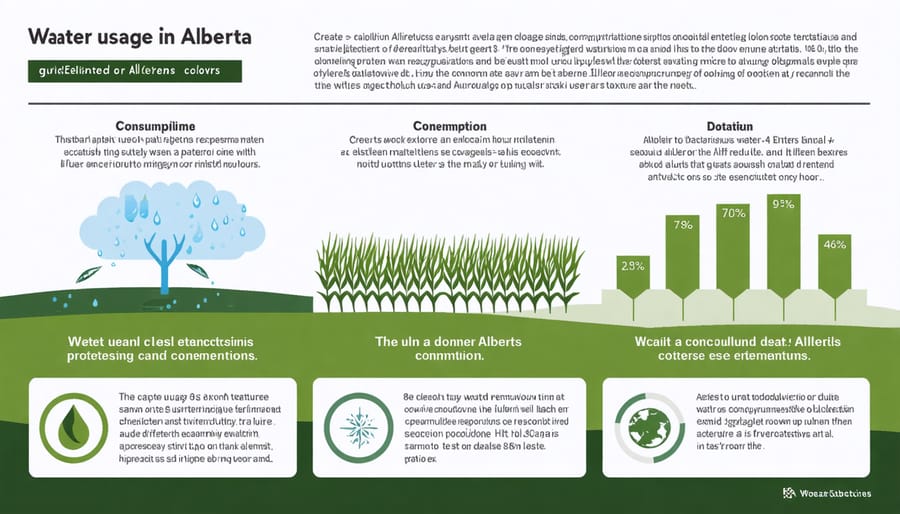
Hidden Financial Impacts of Poor Water Management
When we look beyond the obvious costs of water usage, hidden financial impacts emerge throughout agricultural operations. A recent study by the Alberta Agriculture and Forestry department found that inefficient irrigation systems can lead to an average loss of $45 per hectare annually through increased pumping costs and reduced crop yields.
Supply chain inefficiencies in water management affect multiple stages of production. For example, excess water usage in cleaning and processing facilities can increase wastewater treatment costs by up to 30%. Equipment maintenance costs also rise significantly when dealing with mineral buildup from poor water quality management, with some farmers reporting additional maintenance expenses of $2,000 to $3,000 per year.
Energy costs tied to water pumping and distribution represent another often-overlooked expense. Many Alberta farms could reduce their energy bills by 15-25% through optimized irrigation scheduling and equipment upgrades. Additionally, soil erosion from overwatering can decrease land value and require costly remediation measures, with restoration costs averaging $500 per hectare.
Understanding these hidden costs helps build a stronger business case for investing in water conservation measures, which typically show positive returns within 2-3 growing seasons.
Critical Points of Water Loss in Agricultural Supply Chains
Processing and Packaging Operations
In food processing facilities across Alberta, water conservation plays a crucial role in maintaining sustainable operations. Recent data from the Alberta Food Processors Association shows that the average processing facility uses between 3,000 and 5,000 litres of water per tonne of processed food, highlighting the significant impact of these operations on our water resources.
The implementation of sustainable packaging solutions and water-efficient processing methods can reduce water consumption by up to 40%. Many Alberta facilities have already adopted innovative approaches, such as closed-loop water systems and high-efficiency cleaning protocols, which not only conserve water but also reduce operational costs.
For example, the Red Deer Valley Food Processing Cooperative has implemented a water recycling system that captures and treats process water for reuse in non-food-contact applications. This initiative alone has saved over 2 million litres of water annually. Similar success stories can be found at facilities in Lethbridge and Medicine Hat, where modern spray-cleaning technologies have replaced traditional flood-washing methods.
By adopting water-conscious processing and packaging practices, facilities can significantly reduce their environmental footprint while maintaining the high quality and food safety standards that Canadian consumers expect. The key is to identify areas of water waste and implement targeted solutions that make sense for your specific operation.
Transportation and Storage
In Alberta’s agricultural sector, water loss during transportation and storage represents a significant challenge that often goes overlooked. Studies from Agriculture Alberta show that farms can lose up to 25% of their water resources through inefficient transport systems and poorly maintained storage facilities.
Common issues include leaky irrigation pipes, evaporation from uncovered storage tanks, and spillage during water transfers. For instance, a typical 1,000-litre water tank can lose up to 40 litres per day through evaporation during summer months if left uncovered.
To address these challenges, many Alberta farmers have implemented practical solutions. Using sealed transport systems, installing moisture meters, and maintaining regular equipment inspections can significantly reduce water waste. The Lethbridge Agricultural Research Centre found that farms using properly sealed storage systems reduced their water loss by 30% compared to those using traditional methods.
Real-world success stories include the Morrison Family Farm near Red Deer, which cut their water loss by 40% after installing modern storage tanks with vapor recovery systems. They also implemented a monitoring system that alerts them to potential leaks in their irrigation network.
Simple steps like scheduling regular maintenance checks, using appropriate sealing materials, and investing in quality storage equipment can make a substantial difference. Remember, every litre saved in transportation and storage means more water available for crop production and sustainable farming practices.
Proven Water Conservation Solutions for Canadian Farms
Smart Irrigation Technologies
Modern irrigation technology has revolutionized water management on Alberta farms, offering precise control and significant water savings. Today’s smart systems integrate AI-powered farming solutions with soil moisture sensors, weather monitoring, and automated controls to deliver water exactly when and where crops need it.
These systems typically include soil moisture probes that provide real-time data about field conditions, allowing farmers to make informed decisions about irrigation timing and volume. Weather stations connected to irrigation controllers automatically adjust watering schedules based on rainfall predictions and evaporation rates, preventing overwatering and protecting crops from stress.
Variable-rate irrigation technology has been particularly successful in Alberta’s diverse terrain, allowing farmers to apply different amounts of water to different zones within the same field. This precision approach has helped many local producers reduce water usage by 20-30% while maintaining or improving crop yields.
For example, the Peterson family farm near Lethbridge implemented smart irrigation in 2021 and saved approximately 40 million litres of water in their first season. Their system uses mobile apps for remote monitoring and control, ensuring efficient water distribution across their 800-hectare operation.
Many of these technologies qualify for provincial funding through the Canadian Agricultural Partnership, making them more accessible to Alberta farmers looking to modernize their irrigation practices while conserving water resources.
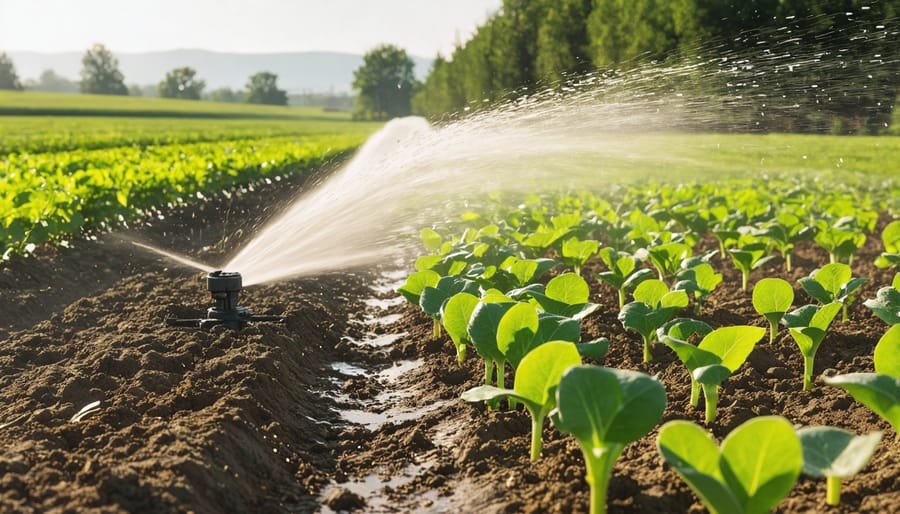
Water Recycling Systems
Water recycling systems are becoming increasingly vital for Alberta’s agricultural community, offering practical solutions for sustainable water management. These systems align perfectly with modern circular supply chain practices and can significantly reduce your farm’s water consumption.
Many Alberta farmers have successfully implemented greywater systems that capture and treat water from washing stations and equipment cleaning for reuse in irrigation. These systems typically include filtration units, storage tanks, and UV treatment components, making the water safe for agricultural use while meeting provincial health standards.
A particularly effective approach is the integration of rainwater harvesting with recycling systems. By collecting rainfall from barn roofs and other structures, farmers can supplement their water supply during drier periods. Storage solutions range from simple cisterns to sophisticated underground tanks with capacities of 50,000 to 100,000 litres.
For greenhouse operations, condensation recovery systems can recapture up to 60% of water lost through plant transpiration. This recovered water is typically cleaner than the original irrigation water and requires minimal treatment before reuse.
Local success stories include the Morrison family farm near Lethbridge, which reduced their annual water consumption by 40% through a combination of rainwater harvesting and greywater recycling. Their system paid for itself within three years through reduced water costs and improved crop yields.
Remember to consult with local agricultural extension services when planning your water recycling system to ensure compliance with regional regulations and maximize efficiency for your specific operation.
Supply Chain Optimization
In Alberta’s agricultural sector, optimizing water use throughout the supply chain is crucial for sustainable farming practices. Recent studies from the University of Alberta show that up to 20% of water loss occurs during transportation and storage phases, presenting a significant opportunity for conservation.
One effective strategy is implementing smart irrigation delivery systems. These systems use GPS-guided trucks and monitored pipeline networks to minimize water loss during transport from source to field. Many Alberta farmers have reported reducing their water waste by 15% simply by upgrading their delivery infrastructure.
Storage solutions play an equally important role. Modern reservoir linings and covers can reduce evaporation by up to 90% compared to uncovered storage. The Lethbridge Agricultural Research Centre has demonstrated that installing floating covers on water storage tanks can save approximately 2.5 million litres of water annually on a typical 640-acre farm.
Regular maintenance and monitoring are essential. Installing water meters at key points in the supply chain helps identify leaks and inefficiencies quickly. The Southern Alberta Irrigation Projects Association recommends monthly inspections of all water transportation equipment and storage facilities.
Local farmer Jim Peterson from Drumheller shares, “After upgrading our storage tanks and implementing a monitoring system, we’ve cut our water losses by nearly 30%. The initial investment paid for itself within two growing seasons through reduced water costs and improved crop yields.”
By focusing on these supply chain improvements, farmers can significantly reduce water waste while maintaining productive operations.
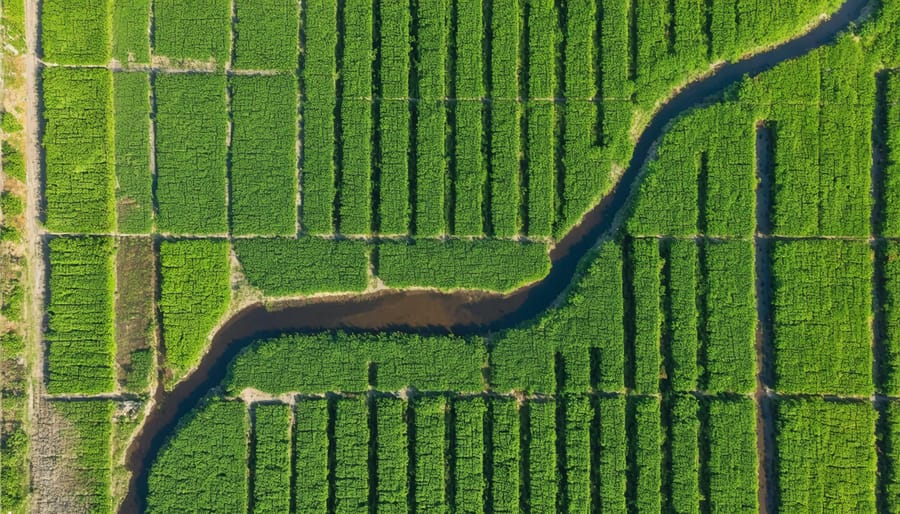
Success Story: The Thompson Family Farm’s Water Conservation Journey
When the Thompson family first noticed their irrigation costs climbing in 2018, they knew something had to change on their 800-hectare farm near Lethbridge. “We were using nearly 40% more water than our neighbors for similar yields,” recalls Sarah Thompson, who manages the farm with her husband Mike and their two children.
Their journey toward water efficiency began with a comprehensive audit of their irrigation system, revealing significant losses through aging infrastructure and inefficient scheduling. Working with local agricultural extension services, the Thompsons developed a three-year plan focusing on sustainable agricultural practices and modern water management techniques.
The family invested in soil moisture sensors and weather monitoring equipment, allowing them to make data-driven irrigation decisions. They also upgraded to a low-pressure pivot system with drop nozzles, which reduced water loss through evaporation. “The initial investment was significant,” Mike explains, “but we recovered the costs within two growing seasons through reduced water and energy bills.”
The results have been remarkable. By 2022, the Thompsons had reduced their water usage by 35% while maintaining crop yields. Their successful implementation of drip irrigation in their vegetable fields has saved an additional 15% in water consumption. They’ve also introduced drought-resistant crop varieties and adjusted their planting schedule to maximize natural rainfall patterns.
The Thompson family now shares their experience with neighboring farms, hosting field days and workshops to demonstrate their water conservation methods. “It’s not just about saving water,” Sarah emphasizes. “It’s about creating a resilient farming operation that can weather future challenges while protecting our resources for the next generation.”
Their success has inspired other local farmers to adopt similar practices, creating a ripple effect of water conservation throughout the Lethbridge farming community. The Thompsons’ story serves as a practical example of how strategic planning and modern technology can transform water management on Canadian farms.
The time to act on water conservation is now, and as members of Alberta’s agricultural community, we have both the responsibility and opportunity to lead by example. Every drop saved today helps secure our farming future for generations to come. By implementing the strategies discussed throughout this guide, you can make a significant impact on water conservation while maintaining productive and profitable operations.
Remember, you’re not alone in this journey. The Alberta Agriculture and Irrigation Ministry offers comprehensive support programs and resources for farmers transitioning to water-efficient practices. Local agricultural extension offices provide free consultations and can connect you with experts who understand our unique regional challenges.
Consider joining one of the many farmer-led water stewardship groups in our province, where you can share experiences and learn from peers who have successfully implemented conservation measures. The Southern Alberta Water Conservation Society hosts monthly meetings and workshops specifically designed for agricultural professionals.
Take the first step today by conducting a water audit of your operation or reaching out to your local agricultural representative. Small changes, when multiplied across our farming community, create substantial impact. Together, we can build a more sustainable and water-wise agricultural sector that serves as a model for the rest of Canada.
For immediate assistance or to learn more about available resources, contact your regional agricultural office or visit the Alberta Water Portal Society’s website for comprehensive guides and support materials.

